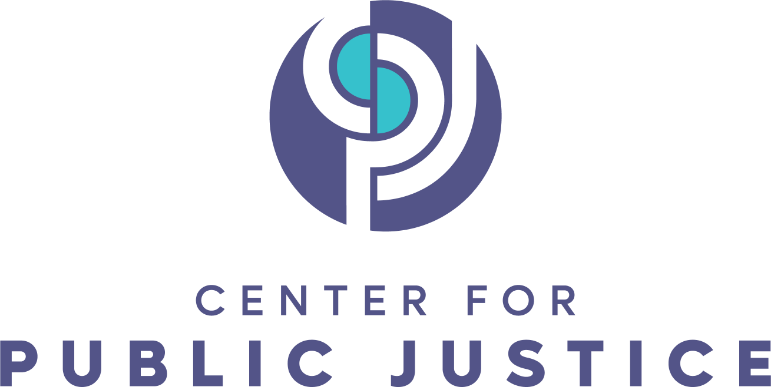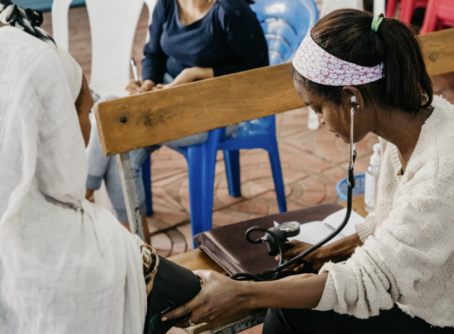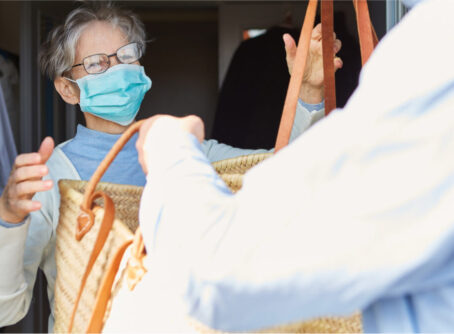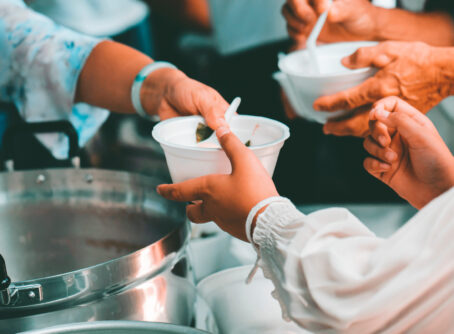
Recently, Shared Justice intern Ezra Craker sat down with food insecurity researcher Cara Cliburn Allen, Ph.D., to discuss the state of food security in the United States, particularly for young adults and college students. Cara Cliburn Allen worked with the Baylor Collaborative on Hunger and Poverty on campus food insecurity, and now works at the Gretchen Swanson Center for Nutrition. All views expressed in the interview below solely reflect the opinion of Cara Cliburn Allen and not the positions of her employers.
EC
To get started with the interview, we’re interested in what brought you to food insecurity research and what motivates you to do this work.
CCA
Thinking about food access is something that I have done since I was a kid. I lived in the city, just outside of the Dallas, Fort Worth area growing up. My grandpa lived in rural Oklahoma and he had a big farm and was a farmer. I spent the summer helping him plant, grow, and then can the fresh produce from his garden. And every year he would say something along the lines of “I bet those kids who you go to school with have never seen a beet or have never seen fresh produce like this… They only know that it comes from a can or they don’t have access to it.” I always thought about that as a kid in relation to being in the city and not necessarily in terms of food access.
Fast forward and my mom is a school principal. At the school that she worked at, she did a lot of work to ensure food access for kids. She started a backpack program in partnership with the food bank at her school. So, I always grew up being attentive to these conversations and thinking about food access.
When I went to grad school, I studied college student success. I was really thinking about what it meant for 18 to 24 year old college students to need food access or food support. Growing up in K through 12 you have school lunch, summer meals, and after school meals. I realized that when you graduate from high school and if you choose to go on to college then you lose that entire support system that provides food access. However, it’s very likely that your financial situation has not changed. That was really what got me thinking about what happens to a college student when they lose support when they graduate high school and can no longer access federal nutrition programs for children. What’s that experience like and how does it shape them in college and how they understand themselves as college students?
EC
As a food insecurity researcher, what’s your sense of what most people do not know about food insecurity? What’s something that most people are missing?
CCA
One, food insecurity or lack of food access is a lot closer to individuals than we might imagine. Hunger can be a very hidden challenge for people. You can’t look at someone and tell that they’re hungry. It is both chronic and episodic, so some households are going to experience hunger consistently or challenges to food access on a regular basis, but for most households it’s more episodic.
But really, when I think about the effect of hunger or lack of food access on individuals, I think about the mental anxiety that comes with struggling to afford food, particularly in the college student context. It can be exhausting wondering where your next meal is coming from. Maybe you’re completely orienting your day around how to access food, or where you can get free food, or whose organization is giving out food, and then you’re having to reorient how you get home from work that day, or how you schedule your day on top of “how am I going to afford XYZ thing?” including food. The mental space and anxiety that it takes up to be hungry and wonder where your next meal is coming from is a really hidden aspect of hunger that we don’t talk about very often.
EC
As you look forward to the next couple of years, what makes you hopeful about the state of nutrition in the US, and what makes you concerned?
CCA
I am very excited about the move to talking about nutrition in the food security space. In the past we were just talking about access to healthy and nutritious food, but there wasn’t as much of a focus on nutrition. The piece of this that gives me pause and what I hope that we can continue to work on is that what we mean when we say nutritious food encapsulates the diversity of our country and that we aren’t nailed into one definition of nutritious.
EC
As a follow up question to that, I’m curious about the tension between not restricting people’s access to unhealthy food, but rather promoting access to healthy food. What does that look like?
CCA
That is a great question and a topic researchers and practitioners are navigating. Choice and nutrition do not have to be mutually exclusive. There has been some really interesting work done in food pantry spaces to help educate about what healthier options are. Some include having a system to denote [the nutrition benefits of a food item] and it doesn’t doesn’t actually restrict what options people choose or don’t choose, but just suggests, “this option has more nutrients” There’s a tension there between choice and nutrition, and as the conversation continues we need to be focused on an inclusive approach with an equity lens. We need to ensure these conversations have diverse voices at the table and that nutritious captures the diversity of our country.
EC
How do you understand the Christian call to feed the hungry in the unique context of 21st century America today? How can Christians specifically get involved in combating food insecurity in their own communities?
CCA
I think often of our call as Christians to address the food needs of people. Even from the very beginning of the biblical text, there’s a mandate to cultivate and steward the Earth, and part of that is in relationship with other people. What does it mean to utilize the resources that were given to serve our neighbors? The Old Testament has lots of encouragement and practices around agriculture and gleaning and leaving food for people who need it. That’s carried through into the New Testament where Jesus is often eating with people.
I think a lot about how Jesus ate alongside people at tables. Food doesn’t just serve as a basic need — for sure it is that — but it’s also a symbol of community and belonging and neighborliness. This perspective should inform both our approach to feeding people as well as our desire to feed people: that Jesus created a table for us. We were invited to participate in God’s table and we should invite others to participate in that table and share food with them as well.
I often get asked by churches how they can participate in increasing access to food for people. I love that churches are thinking about this. I think the first instinct can often be: what can my specific church do? Should we start up a food pantry or have a soup kitchen? Though those one off initiatives are good, I think it’s very likely that there are probably already organizations doing that work in a community. I think it’s really important for Christians and churches to partner with the work that’s already happening.
One approach that the Baylor Collaborative on Hunger and Poverty utilizes is building coalitions and encouraging organizations that are interested in addressing hunger to come together to reduce the duplication of efforts and move forward as a community to address hunger needs. When you bring all of the people interested in this cause to the table — pastors and nonprofit leaders and grocery store owners and business leaders— to think about “how do we ensure food access to our entire community?” and think about it on a community level, pulling people together is really important.
I suggest thinking about the local level, but also paying attention to local policies and state policies. Small shifts at the local level can have a big impact on food access, such as adding a bus stop near a grocery store.
EC
What can you tell us about your book project?
CCA
I’m working on it with two co-authors, Nathan Alleman, who’s a faculty member at Baylor, and Sarah Madsen, who is a doctoral candidate at Baylor. We studied how students experience food insecurity at selective affluent university environments where experiencing food insecurity is not normative, and how this experience shapes how students understand themselves. We dive into the intersection of university prestige and a student struggling to afford food in that context, and what that intersection illuminates f about the nature of selective institutions as well as how a student navigates that space. We studied 3 campuses: a state institution, a liberal arts institution and public research or private research university.
EC
What do you hope that this book changes about the food insecurity conversation?
CCA
A lot of the college student food security conversation has been focused around understanding need and then responding to need. That’s because we care about responding and supporting food needs. How I hope our book shifts the conversation is thinking about how responses are contextualized within an environment and meet the needs of the students on campus. The way that we stand up a food pantry may not reflect the needs of the students. Maybe it’s open from 8 to 5 and students can’t access it from 8 to 5 because of their schedules.
I think we’re really pushing administrators to think about cultivating solutions that are student informed and student driven; responses need to meet students’ actual needs and really help them participate as full students in the environment.
EF
I’d be curious to know how you started to research food insecurity among college students. What has led your research in that direction and how have researchers begun to discover food insecurity among this population?
CCA
Food insecurity has always existed on college campuses. We just didn’t talk about it. The first food pantry on a college campus opened in the 90s. In 2008 post-recession, this conversation started to emerge. I was studying in 2013 getting my masters and Ph.D. in Higher Education Administration, so my focus was thinking about student success and access to college. How do we get students into college? And then how do we make sure they’re successful as they move through college? As we’ve increased access, we’ve had to think, how do we create spaces for all people to be successful in college? What are barriers to college completion? Food insecurity has started to emerge as one of those potential challenges.
The Hope Center for Community College and Justice located at Temple [University] started doing work in this space. I went to a session at a conference led by their former director Sara Goldrick-Rab, and they’d written the first report of college student food insecurity. The conversation was really happening around community college students and some public four year institutions. I thought, if it exists there, I’m sure that it exists in more selective contexts, but nobody’s writing about it.
So, I convened a team of people at Baylor: some people from student success, some people from student life who might be interested in this topic. We started looking into whether or not students at Baylor were experiencing food insecurity. We created some initiatives to respond when we discovered that they were. So, it’s that link between research and practice that got me invested as a researcher in this space.
EF
Thanks for elaborating on that. I know you touched on it earlier when we were talking.
CCA
Baylor’s doing a lot of great work. They have a free farmers market that they host once a semester. The goal of that event is to increase access to fresh produce and awareness that this is a thing college students deal with. We don’t want to normalize it in the sense of “it’s normal to be hungry in college,” because we don’t want that to be normal. But we do want to say, “hey, it’s OK if you utilize these food resources.” Just like you would go to the gym, just like you might go to the counseling center, just like you might go to academic support, it’s also OK to access the food resources we have for you. So that fine line there between normalizing that it’s something every college student should go through because it’s absolutely not, but also encouraging students to to take advantage of resources that we have for them.
EF
What recommendations do you have for young adults who want to make sure that the people in their communities have access to food?
CCA
If they’re in college, like a technical school or community college or a four year school, there’s a likelihood that this conversation is happening on their campus. I’m a huge proponent that student voices are necessary in this conversation. So, I would encourage them to see if it’s happening and how they can get involved in serving on a committee or providing recommendations or answering surveys. Opportunities to share their lived experience or their peer lived experience is essential in helping create solutions that meet the actual needs of students.
It’s very likely that outside the college context, there are conversations happening around food access. I encourage people to volunteer first at a food bank or a food resource center or food pantry. So much good work is happening there and I think engaging in the issue alongside neighbors who are experiencing food security before moving to the next step of affecting change is really important.I found that there are few people who are OK with individuals being hungry. We may have different beliefs in solutions to hunger. But it is an area where I think we can find unity in responding or even talking with people who may think differently about politics or policies than we do. Often we can come together and agree that we don’t want people to be hungry.
MP
How did the pandemic change the situation of food insecurity for young people?
CCA
I think that that is very individualized, whether they stayed at campus or went home. It was complex at the national level. We did not see hunger levels change, or food security levels change in the way that we expected to. That’s in part because we threw everything we could policy wise at it. At the federal level, the government expanded access to federal nutrition programs to try and ensure food access for citizens through the pandemic. We increased college student access to SNAP — in the sense that they created waivers to make it more easily accessible for college students to get SNAP. Much was done at the federal level to prevent food security numbers from rising and they’ve stayed steady. As some of those waivers expire lots of us in this space are looking to see how food security and insecurity shifts.
EF
The work that you guys are doing sounds really interesting. If you hear of other research that we should know about, send it my way.
CCA
In terms of the intersection of faith and life, I definitely, definitely encourage you all to look at Baylor researchers in general. In my department specifically — Higher Education Studies and Leadership — Nathan Alleman and Perry Glanzer have written some great books about the intersection of faith and higher education.





